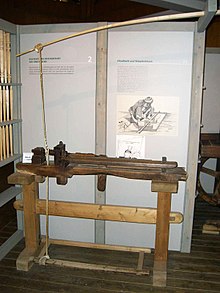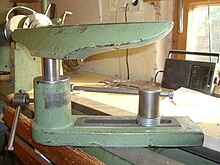Lathe
The lathe or wood lathe of the wood turner is a machine for the production of rotating bodies primarily from wood , but also from ivory , horn , amber , alabaster , serpentine , plexiglass and other materials. In contrast to the lathe , which has a tool holder and is used for metalworking, in the lathe the tool is guided by hand. The woodturner generally calls the activity at the lathe turning , while it is popularly called turning in the hobby area .
The name
Contrary to the popular name wood lathe , in the technical literature of the wood turner, his production machine is called lathe or, more rarely, wood lathe . The reason lies in the late separation of the metal turner from the woodturning trade. Meanwhile, the lathe operator speaks of the lathe, while the wood turner continues to speak of the lathe. The historical Dreher (also dreier, dreger, dräier, träier, dreer) was a very general term. He describes a number of historical crafts that made use of the lathe. The term wood turner developed specifically from the woodworking lathe operator.
history
The invention of the lathe probably goes back to the Greeks at the end of the 2nd millennium BC. BC back. The development is tied to the first turned item and may possibly be a long time ago, since the original form of the lathe was created from the oldest device known to man, the fiddle drill . The axis of rotation was merely moved to the horizontal plane. The first pictorial representation that describes a forerunner of our modern lathe was in an Egyptian tomb from the year 300 BC. Found. For a long time, the principle did not change significantly, so that the rotary motion continued to change continuously. The development of the rocker lathe brought relief , as the woodturner could now operate the drive with his foot and had both hands free for the actual work. Only the cranked shaft by Leonardo da Vinci gave the turner the uniform rotary motion. From the lathe of the drayer or now the turner, the lathe of the metalworker specialized, which was built much more stable and had a mechanical feed. The further development of technology created various forms of drive up to the separate electric motor that is common today . The CNC-controlled fully automatic machines represent further developments today, without which industrial mass production would hardly be possible.
Working principle on the lathe
The workpiece ( turned part ) is clamped in the machine between the headstock and tailstock or attached to one side of the headstock by means of a chuck and set in rotation. While the tool is fixed with one hand by pressure on the tool rest and pressed against the rotating workpiece, the second hand guides the tool along the longitudinal and transverse axis of the rotating part and tilts it around the horizontal and vertical axis of the tool, whereby it turns the contact surface on the tool rest is the pivot point (of the tool).
Further options for machining workpieces on the lathe are described in detail under Turning .
Basic structure of the lathe
The basic structure of the lathe has hardly changed for a long time. The names of the components themselves, which are identical in wooden and metal lathes and are reminiscent of their common wooden ancestors, bear witness to this long-term, well-thought-out design.
Machine bed
The machine bed generally consists of two horizontal cheeks that rest on two uprights. The parts are usually made of cast iron in order to ensure a high degree of rigidity and thus high working accuracy. But there are also other designs, especially known from the leisure sector. The distance between the cheeks is used to guide the other components. The machine bed can be made in various designs, such as: B. cranked (for larger cross wood diameters) or extremely long (e.g. for turning long columns).
Headstock
The headstock is located on the left side of the lathe (on left-hand lathes on the right) and represents the most important part of the lathe. It normally consists of the bearing block , the horizontal bearing on both sides, the counter-pressure bearing , the spindle (shaft) and the pulleys . But other construction methods are also known. The hollow spindle or hollow shaft is used to transfer the rotary motion to the workpiece via the workpiece attachment. It can be attached using various drivers, bung, stop, screw, jaw or other chucks. The power of the motor can be transmitted via V-belts, flat belts, cords, gears or directly to the shaft. Electronic speed control corresponds to the current state of the art.
Tailstock
The sliding tailstock is required as a counter holder for longer workpieces. It is also mostly made of cast iron. The workpiece is pressed between the tailstock and the headstock using a handwheel or lever. A quill with a center point is usually used for this on the tailstock shaft.
Palm rest with holder
The palm rest holder lies flat on the lathe bed and is attached to it, adapted to the respective work. The palm rest itself is used to rest the hand with the tool. They are available in different lengths and, like the bracket itself, are mostly made of cast iron. It is rotatable and height-adjustable thanks to the vertical guide. All parts of the lathe must be firmly fixed during the turning process.
Special components
A lathe can be equipped with various additional components. These include, for example:
Fixed tools similar to metal processing can also be used.
Web links
Individual evidence
- ↑ G. Böckelmann: Handbook of turning . 2nd Edition. Urania Ravensburger, Berlin 2000, ISBN 3-332-00919-2 , p. 6 .
literature
- Hugo Knoppe: Handbook of the turnery . F. Ernst Steiger, Leipzig 1938, DNB 574373454 (Reprint: 1989, ISBN 3-88746-231-9 ).
- Fritz Spannagel: The turner's factory . Th. Schäfer, Hannover 1981, ISBN 3-88746-014-6 (reprint of the 2nd edition from 1948).
- Rolf Steinert, Herbert Hegewald: The turner . 5th edition. VEB Fachbuchverlag Leipzig, Leipzig 1981, DNB 821086618 .
- G. Böckelmann: Handbook turning . 2nd Edition. Urania Ravensburger, Berlin 2000, ISBN 3-332-00919-2 .




